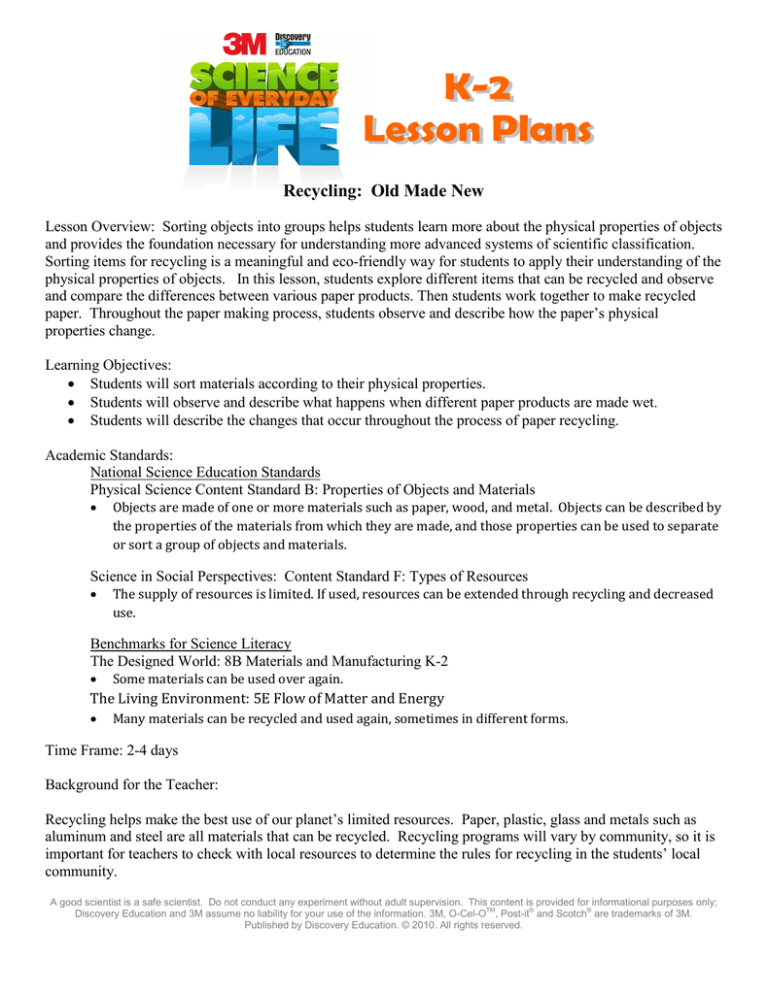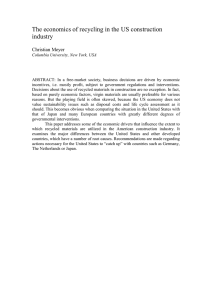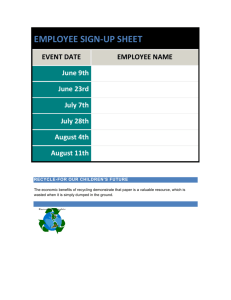
Recycling: Old Made New
Lesson Overview: Sorting objects into groups helps students learn more about the physical properties of objects
and provides the foundation necessary for understanding more advanced systems of scientific classification.
Sorting items for recycling is a meaningful and eco-friendly way for students to apply their understanding of the
physical properties of objects. In this lesson, students explore different items that can be recycled and observe
and compare the differences between various paper products. Then students work together to make recycled
paper. Throughout the paper making process, students observe and describe how the paper’s physical
properties change.
Learning Objectives:
Students will sort materials according to their physical properties.
Students will observe and describe what happens when different paper products are made wet.
Students will describe the changes that occur throughout the process of paper recycling.
Academic Standards:
National Science Education Standards
Physical Science Content Standard B: Properties of Objects and Materials
Objects are made of one or more materials such as paper, wood, and metal. Objects can be described by
the properties of the materials from which they are made, and those properties can be used to separate
or sort a group of objects and materials.
Science in Social Perspectives: Content Standard F: Types of Resources
The supply of resources is limited. If used, resources can be extended through recycling and decreased
use.
Benchmarks for Science Literacy
The Designed World: 8B Materials and Manufacturing K-2
Some materials can be used over again.
The Living Environment: 5E Flow of Matter and Energy
Many materials can be recycled and used again, sometimes in different forms.
Time Frame: 2-4 days
Background for the Teacher:
Recycling helps make the best use of our planet’s limited resources. Paper, plastic, glass and metals such as
aluminum and steel are all materials that can be recycled. Recycling programs will vary by community, so it is
important for teachers to check with local resources to determine the rules for recycling in the students’ local
community.
A good scientist is a safe scientist. Do not conduct any experiment without adult supervision. This content is provided for informational purposes only;
Discovery Education and 3M assume no liability for your use of the information. 3M, O-Cel-OTM, Post-it® and Scotch® are trademarks of 3M.
Published by Discovery Education. © 2010. All rights reserved.
Paper recycling is the process of recovering waste paper and remaking it into new paper products. According to
the American Forest and Paper Association, 57.4% of paper consumed in the United States was recovered for
recycling in 2008. Every ton of paper recovered for recycling saves 3.3 cubic yards of landfill space. Paper
products that can be recycled include corrugated cardboard, magazines, office paper, newspaper, paperboard
(e.g. cereal boxes) and phone books.
Paper comes from trees. It contains fibers that are shredded and mixed with water to make a pulp. This pulp is
then dried and pressed to make paper. Each time paper is recycled, the fiber length decreases which impacts its
strength. It is estimated that paper can be recycled up to 7 times. As students observe and compare different
types of paper and go through the process of recycling paper, they may observe how the strength of paper fibers
can vary.
As students think about the importance of recycling, they are sure to discuss the fact that paper comes from
trees. Cutting down too many trees is bad for the environment in many ways—animals lose their habitat,
deforestation can cause soil erosion, and trees provide the earth with much needed oxygen. However, it is
important to note that paper is made from a renewable resource. While it may take many years for a tree to
grow, the US forest products industry plants an average of 1.7 million trees every day. That is 5 new trees for
every tree that is harvested for paper products! Through a combination of recycling and replanting trees, we
can use our resources responsibly to make sure they are available for years to come.
Materials:
For the teacher
Chart paper
Marker
Chart showing 3 Basic Steps to Recycle Paper
1. Cut or tear paper
2. Use a blender to make pulp
3. Spread the pulp on a screen and let it dry
Examples of recycled products with the recycle symbol (e.g. sticky notes, padded mailers, etc.)
Items from a recycle bin (glass, plastic, metal, and paper)
Blender (Note: Consider the location of your outlets and where students will be sitting to watch
the blender part of the paper making process. You may need to have an extension cord.)
Pitcher of water
Optional –extension cord
For each student
Scissors
Recycling: Old Made New: Student Resource
Recycling: Old Made New: Home Connection Resource
A good scientist is a safe scientist. Do not conduct any experiment without adult supervision. This content is provided for informational purposes only;
Discovery Education and 3M assume no liability for your use of the information. 3M, O-Cel-OTM, Post-it® and Scotch® are trademarks of 3M.
Published by Discovery Education. © 2010. All rights reserved.
Blank paper
Pencil
Smocks (for Session 2)
(For each student group)
Set of 10-12 objects from the classroom for sorting
Samples of paper (tissue paper, newspaper, copy paper, paper egg carton, cardstock, and
toilet paper)
Hand lens/magnifiers
Papers from the school recycling bin
Water
Metal screens (enough for groups of 5 or 6)
Plastic containers slightly larger than metal screen (optional)
Newspaper to cover tables
Soap and water for clean up
Rags or towels for spills and clean up
Plastic ruler or straight edge
Classroom Activities:
Session 1
1. Divide students into small groups. Provide each group with a set of objects from the classroom to sort
based on properties. Circulate among the groups and ask: What is the rule you used to sort the objects?
Once students have explained their sorting rule, encourage them to find a different way to sort the
objects.
2. Show students a group of objects from a recycling bin. As a class, sort the objects into paper, glass,
metal, and plastic and discuss the properties of each material. Discuss reasons for recycling. (Recycling
helps us to conserve limited resources. Instead of burying all of our trash in a landfill, recycling allows
us to use materials again and again.)
3. Show students examples of paper products in the classroom that are made from recycled products (e.g.
sticky notes, mailing envelopes, etc.) Tell students that in this lesson, they will focus on paper
recycling. Ask students to explain what they think they already know about paper recycling and what
they would like to learn. Record this on a class KWL chart (A chart with columns showing what
students think they know, want to know, and have learned.)
A good scientist is a safe scientist. Do not conduct any experiment without adult supervision. This content is provided for informational purposes only;
Discovery Education and 3M assume no liability for your use of the information. 3M, O-Cel-OTM, Post-it® and Scotch® are trademarks of 3M.
Published by Discovery Education. © 2010. All rights reserved.
4. Tell students that paper recycling is the process of recovering waste paper and remaking it into new
paper products. Discuss how papers like newspapers, white office paper, cardboard, and phone books
are typically recycled. Papers with special coatings like wax paper and stickers, papers from food
products such juice boxes or greasy pizza boxes, and papers for hygiene like paper towels and tissues are
not recycled. Paper is made from trees. Recycling paper helps to cut down on the number of trees that
are cut down. When trees are cut down, animals lose homes and soil erodes more easily. Trees are
plants that provide the earth with oxygen we need to breathe.
5. Distribute Old Made New: Student Resource Page 1. Provide small groups of students with magnifiers
and samples of a variety of paper products to observe (tissue paper, newspaper, copy paper, paper egg
carton, cardstock, and toilet paper) Students should observe and describe each type of paper based on its
physical properties.
6. Allow students to predict aloud what will happen when 10 drops of water are added to each type of
paper. Provide students with droppers and water. Students should test each type of paper and record
their findings.
7. Bring closure to Session 1 by refocusing student attention on the class KWL chart they started at the
beginning of the lesson. Begin filling in the last column of the chart by asking students to share one
thing they have learned so far about paper. Inform students that in the next session they will be
completing an investigation that will require smocks or clothing that can get messy.
Session 2
8. Review and discuss what students learned from Session 1. Tell students that in this session, they
will learn more about paper recycling by working together as a class to make their own recycled
paper.
9. Protect tables by covering them with newspaper and distribute smocks to protect clothing.
Display the chart 3 Basic Steps to Recycle Paper (See materials section) for the class to observe
during the lesson. Then follow the process below to make recycled paper as a class. Explain that
for safety reasons, you the teacher will be operating the blender. As students go through the steps
ask them to describe orally how the paper is changing through the process.
A. Allow students to tear up paper from the recycling bin into little bits.
B. Put the paper in a blender.
C. Add just enough water to soak the paper thoroughly.
A good scientist is a safe scientist. Do not conduct any experiment without adult supervision. This content is provided for informational purposes only;
Discovery Education and 3M assume no liability for your use of the information. 3M, O-Cel-OTM, Post-it® and Scotch® are trademarks of 3M.
Published by Discovery Education. © 2010. All rights reserved.
D. Place the lid on the blender and blend on medium speed. Add water as needed.
E. Be sure each screen is positioned over newspaper or a large plastic container to catch any excess water. Pour
the pulpy mixture over each group’s screen. Students should work together to smooth out the mixture over
the screen using the edge of a plastic ruler or straight edge to smooth out the mixture.
F. Allow the pulpy mixture to dry thoroughly (1-2 days).
10. After the paper is dry, allow students to use magnifiers to observe and describe the paper. Show
students the samples of tissue paper, newspaper, copy paper, paper egg carton, cardstock, and
toilet paper that they observed in Session 1. Students should compare their new recycled paper
with the previous samples to determine which sample their new recycled paper most closely
resembles in look and texture. Discuss how might the process be modified to make the paper
more flat? (e.g. use books to press it down during the drying process.)
11. Provide each student with a sample of the recycled paper to take home. Discuss the assignment
students will have as a Home Connection. First, students will need to explain to their parents the
process they used to make the recycled paper. Then students should work with their parents to
use the recycled paper sample they have taken home to decorate a greeting card for a family
member or friend. Finally, students should discuss with their parents some ways they can reduce
paper waste and recycle more in their homes.
12. Bring closure to the lesson by asking students to share what they have learned about paper and
recycling. Record student ideas on the class KWL chart.
Home Connections:
Students describe the process they used to make the sample of recycled paper they have brought home.
Students and their parents work together to use the paper to decorate a greeting card for a family
member or friend. Families will discuss some ways to reduce paper waste and recycle more in their
homes.
Assessment:
Provide students with a blank sheet of paper. Ask students to draw a diagram showing the main steps
for recycling paper.
A good scientist is a safe scientist. Do not conduct any experiment without adult supervision. This content is provided for informational purposes only;
Discovery Education and 3M assume no liability for your use of the information. 3M, O-Cel-OTM, Post-it® and Scotch® are trademarks of 3M.
Published by Discovery Education. © 2010. All rights reserved.
Name__________________________
Date______________________
Paper Observations
Directions:
Observe and describe different types of paper when it is dry and wet.
Record your observations in the chart below using words and/or pictures.
Dry
Wet
(10 drops of water)
Tissue paper
Newspaper
Copy paper
Egg carton
Cardstock
Toilet paper
A good scientist is a safe scientist. Do not conduct any experiment without adult supervision. This content is provided for informational purposes only;
Discovery Education and 3M assume no liability for your use of the information. 3M, O-Cel-OTM, Post-it® and Scotch® are trademarks of 3M.
Published by Discovery Education. © 2010. All rights reserved.
Home Connection Resource
Dear Parent or Guardian,
Your child has been learning about properties of objects and how they change. Today your child participated in
making recycled paper. Just take a look at the sample he/she has brought home! Complete the following tasks
together with your child to help reinforce and apply his/her understanding of science concepts:
Ask your child to describe the recycled paper sample (e.g. texture, color, etc.)
Ask your child to explain how paper is recycled. (Cut or tear paper; use a blender to make pulp;
spread the pulp on a screen; and let the pulp dry)
Use the recycled paper sample and other papers to create a greeting card for a friend or family
member.
Discuss ways your family can reduce paper waste and recycle more in your home. Write down a
family plan.
A good scientist is a safe scientist. Do not conduct any experiment without adult supervision. This content is provided for informational purposes only;
Discovery Education and 3M assume no liability for your use of the information. 3M, O-Cel-OTM, Post-it® and Scotch® are trademarks of 3M.
Published by Discovery Education. © 2010. All rights reserved.






